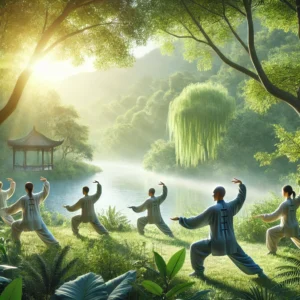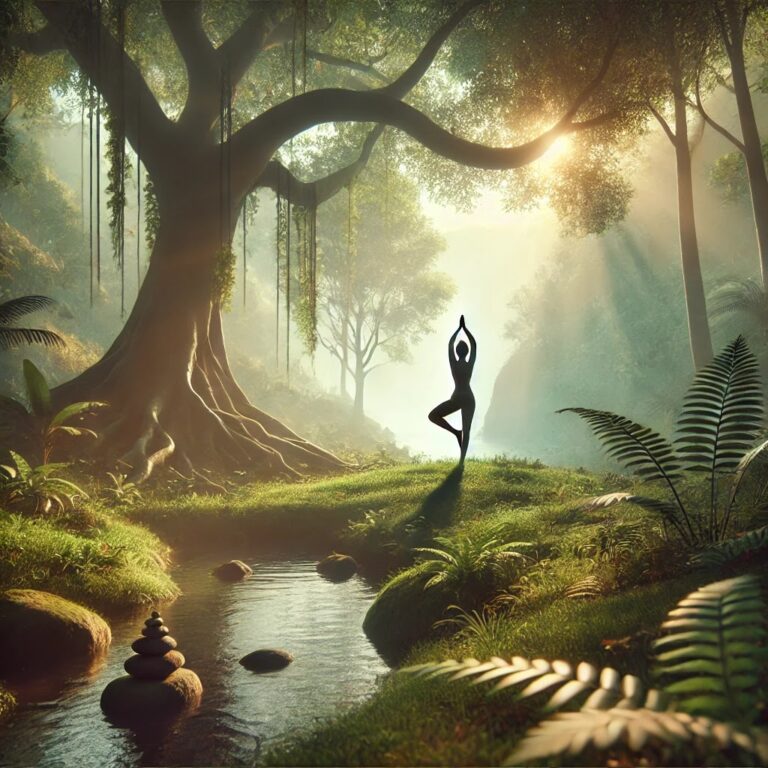
Tai Chi, or Tai Chi Chuan, is a centuries-old practice originating in China that harmonizes body, mind, and spirit through deliberate, flowing movements. A fusion of martial arts, meditation, and traditional Chinese medicine, Tai Chi is often referred to as “meditation in motion” for its seamless blending of physical activity and mindfulness. Its philosophy is rooted in Taoism, emphasizing balance, energy flow (Qi), and interconnectedness. Beyond its roots in self-defense, Tai Chi is widely recognized for its holistic health benefits, making it a transformative practice for people of all ages.
In this article, we’ll explore the history, principles, styles, health benefits, comparisons with other practices like yoga, and how to get started with Tai Chi. A practice as vast and enriching as Tai Chi deserves a deep dive to uncover the many layers it offers.
The Origins of Tai Chi
Tai Chi emerged during the Ming dynasty (1368–1644) and was influenced by ancient Taoist philosophies of balance, natural flow, and harmony. Legend credits Chen Wangting, a military officer in the Chen Village, as the creator of Tai Chi. Initially designed as a martial art for self-defense, it also incorporated health-promoting exercises.
The name “Tai Chi Chuan” translates to “Supreme Ultimate Fist,” reflecting its original martial art intent. However, the philosophical underpinning of Tai Chi as a balance between Yin (passive) and Yang (active) energies laid the groundwork for its evolution into a practice promoting health and well-being.
Philosophical Foundations
At the heart of Tai Chi is the Taoist philosophy of Yin and Yang, representing opposing but complementary forces in nature. This philosophy is expressed in Tai Chi through movements that flow seamlessly from one to the next, alternating between soft and firm, slow and fast, or relaxed and focused. The practice embodies the dynamic balance of these energies, fostering harmony within the practitioner.
The concept of Qi (pronounced “chee”)—the life energy that flows through all living beings—is central to Tai Chi. Practitioners aim to cultivate and balance Qi through controlled breathing, precise movements, and mental focus.
The Principles of Tai Chi
The essence of Tai Chi lies in adhering to its five foundational principles:
- Relaxation (Fang Song)
Releasing physical and mental tension is fundamental to Tai Chi. Relaxation fosters fluid movements and allows energy to flow freely. - Alignment
Proper posture and alignment are essential for balance and energy flow. Practitioners maintain a straight yet relaxed spine, ensuring efficient movement. - Balance
Tai Chi enhances physical balance by shifting weight smoothly from one leg to the other, promoting stability and agility. - Breathing (Tu Na)
Breathing in Tai Chi is slow, deep, and coordinated with movements, enhancing oxygen intake and calming the mind. - Mindfulness
Tai Chi emphasizes being fully present, concentrating on each movement and its connection to breath and energy flow.
Styles of Tai Chi
Over time, Tai Chi branched into several distinct styles, each with unique characteristics:
1. Yang Style
- Most popular worldwide and accessible to beginners.
- Characterized by slow, gentle, and flowing movements.
- Focuses on relaxation and continuous energy flow.
2. Chen Style
- The oldest and most traditional style.
- Combines slow, smooth movements with sudden, explosive bursts of power.
- Suitable for those seeking a more physically demanding practice.
3. Wu Style
- Features small, subtle movements emphasizing balance and precision.
- Often practiced by those looking for a gentle, meditative experience.
4. Sun Style
- Known for upright postures and fluid transitions.
- Incorporates elements of Qigong for added health benefits.
5. Hao Style
- Focuses on precision, internal energy, and small, intricate movements.
- Practiced primarily by advanced Tai Chi enthusiasts.
Each style caters to different needs and fitness levels, making Tai Chi accessible to everyone.
Health Benefits of Tai Chi
Tai Chi’s holistic approach provides physical, mental, and emotional benefits:
Physical Benefits
- Improved Balance: The slow shifting of weight enhances stability, reducing the risk of falls.
- Flexibility: Gentle movements increase range of motion in joints and muscles.
- Strength: Builds core strength through controlled, sustained movements.
- Posture: Emphasizes proper alignment, improving posture and reducing strain on the spine.
Mental Benefits
- Stress Reduction: The meditative aspect calms the mind and lowers cortisol levels.
- Improved Focus: Mindful movements enhance concentration and mental clarity.
- Emotional Balance: Promotes feelings of inner peace and emotional resilience.
Chronic Conditions
Studies show Tai Chi alleviates symptoms of:
- Arthritis by improving joint mobility.
- Hypertension through relaxation and stress relief.
- Fibromyalgia by reducing fatigue and muscle pain.
Cognitive Benefits
Regular practice has been linked to improved memory, problem-solving skills, and overall cognitive function in older adults.
Comparing Tai Chi and Yoga
While Tai Chi and Yoga share similarities as mind-body practices, they differ in origins, techniques, and objectives.
| Aspect | Tai Chi | Yoga |
|---|---|---|
| Origin | China | India |
| Focus | Dynamic, flowing movements | Static postures and flexibility |
| Meditative Element | Integrated into movement | Present in poses and breathing |
| Pace | Continuous, slow | Can vary from slow to vigorous |
| Goal | Cultivating energy flow (Qi) | Union of body, mind, and spirit |
| Physical Effort | Low-impact, gentle | Ranges from gentle to physically demanding |
| Health Benefits | Enhances balance, stress relief | Improves strength, flexibility, mindfulness |
Getting Started with Tai Chi
Embarking on your Tai Chi journey is simple and rewarding. Here are steps to get started:
- Find an Instructor or Class
While videos and apps can be helpful, learning Tai Chi with an experienced instructor ensures correct posture and alignment. - Wear Comfortable Clothing
Loose, comfortable clothing allows for free movement. - Start with Basics
Begin with warm-up exercises and simple movements like “Grasping the Bird’s Tail.” - Be Patient
Tai Chi is about progress, not perfection. Focus on consistency and enjoy the journey. - Practice Regularly
A few minutes daily can yield significant benefits over time.
Advanced Tai Chi Practices
As practitioners advance, they may explore:
- Push Hands: Partnered exercises focusing on sensitivity and balance.
- Weapons Forms: Practices incorporating swords or fans to enhance precision and strength.
- Meditative Depth: Deeper focus on internal energy and spiritual growth.
Tai Chi in Modern Life
Tai Chi has transcended its origins to become a global phenomenon. It is now practiced in parks, community centers, and gyms worldwide. Modern adaptations focus on the health and stress-relief aspects, making Tai Chi a popular choice for people seeking balance in their hectic lives.
Tai Chi is a timeless practice that bridges the gap between physical health and inner harmony. Whether you’re seeking a low-impact exercise, a meditative practice, or a path to self-discovery, Tai Chi offers something for everyone. Its universal appeal lies in its ability to adapt to individual needs, making it a perfect practice for improving your overall quality of life.

